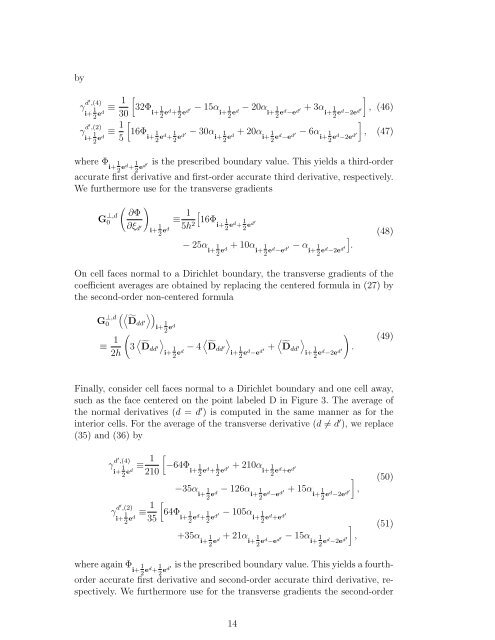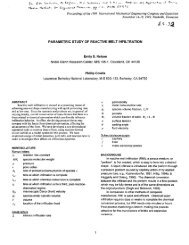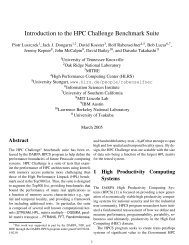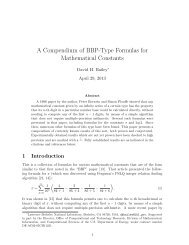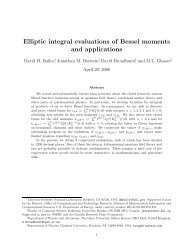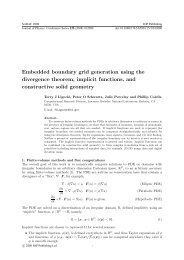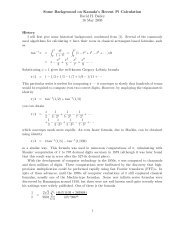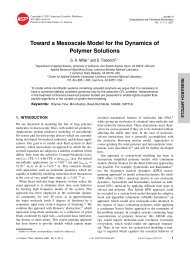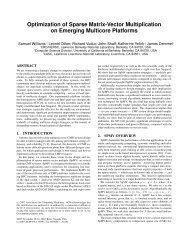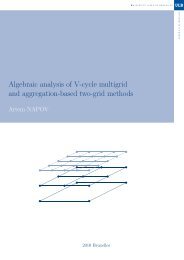High-Order, Finite-Volume Methods in Mapped Coordinates
High-Order, Finite-Volume Methods in Mapped Coordinates
High-Order, Finite-Volume Methods in Mapped Coordinates
Create successful ePaper yourself
Turn your PDF publications into a flip-book with our unique Google optimized e-Paper software.
yγ d′ ,(4)i+ 1 2 ed ≡ 1 30γ d′ ,(2)i+ 1 2 ed ≡ 1 5[]32Φ 1 i+2 ed + 1 − 15α 1 − 20α2 ed′ i+2 ed i+ 1 + 3α2 ed −e d′ 1 i+, (46)2 ed −2e d′[]16Φ 1 i+2 ed + 1 − 30α 1 + 20α2 ed′ i+2 ed i+ 1 − 6α2 ed −e d′ 1 i+, (47)2 ed −2e d′where Φ i+12 ed + 1 2 ed′ is the prescribed boundary value. This yields a third-orderaccurate first derivative and first-order accurate third derivative, respectively.We furthermore use for the transverse gradients( ) ∂ΦG ⊥,d0≡ 1 [16Φi+∂ξ d ′i+ 1 5h 2 12 ed 2 ed + 1 2 ed′− 25α i+12 ed + 10α i+ 1 2 ed −e d′ − α i+12 ed −2e d′ ].(48)On cell faces normal to a Dirichlet boundary, the transverse gradients of thecoefficient averages are obta<strong>in</strong>ed by replac<strong>in</strong>g the centered formula <strong>in</strong> (27) bythe second-order non-centered formulaG ⊥,d0(〈˜D dd ′〉)i+ 1 2 ed≡ 1 (3 〈˜D 〉dd ′2hi+ 1 − 4 〈˜D 〉dd ′2 ed i+ 1 + 〈˜D )〉dd2 ed −e d′ ′i+ 1 .2 ed −2e d′(49)F<strong>in</strong>ally, consider cell faces normal to a Dirichlet boundary and one cell away,such as the face centered on the po<strong>in</strong>t labeled D <strong>in</strong> Figure 3. The average ofthe normal derivatives (d = d ′ ) is computed <strong>in</strong> the same manner as for the<strong>in</strong>terior cells. For the average of the transverse derivative (d ≠ d ′ ), we replace(35) and (36) byγ d′ ,(4)i+ 1 ≡ 1 [−64Φ 12 ed 210 i+2 ed + 1 + 210α 12 ed′ i+2 ed +e d′]−35α 1 − 126α i+2 ed i+ 1 + 15α2 ed −e d′ 1 i+,2 ed −2e d′γ d′ ,(2)i+ 1 ≡ 1 [64Φ 12 ed 35 i+2 ed + 1 − 105α 12 ed′ i+2 ed +e d′]+35α 1 + 21α i+2 ed i+ 1 − 15α2 ed −e d′ 1 i+,2 ed −2e d′(50)(51)where aga<strong>in</strong> Φ i+12 ed + 1 2 ed′ is the prescribed boundary value. This yields a fourthorderaccurate first derivative and second-order accurate third derivative, respectively.We furthermore use for the transverse gradients the second-order14


